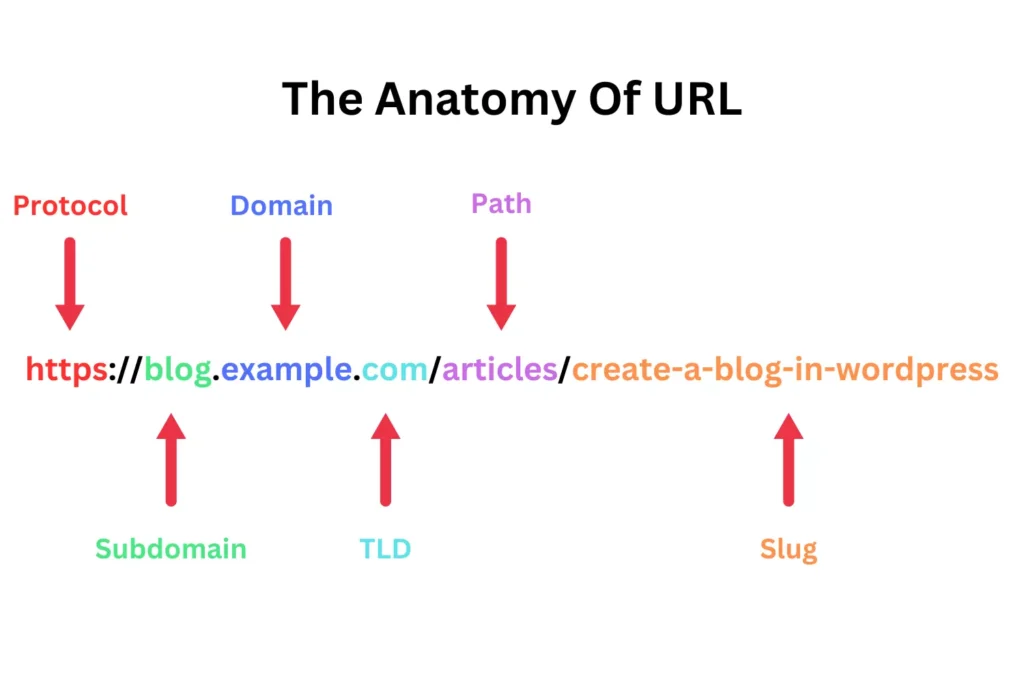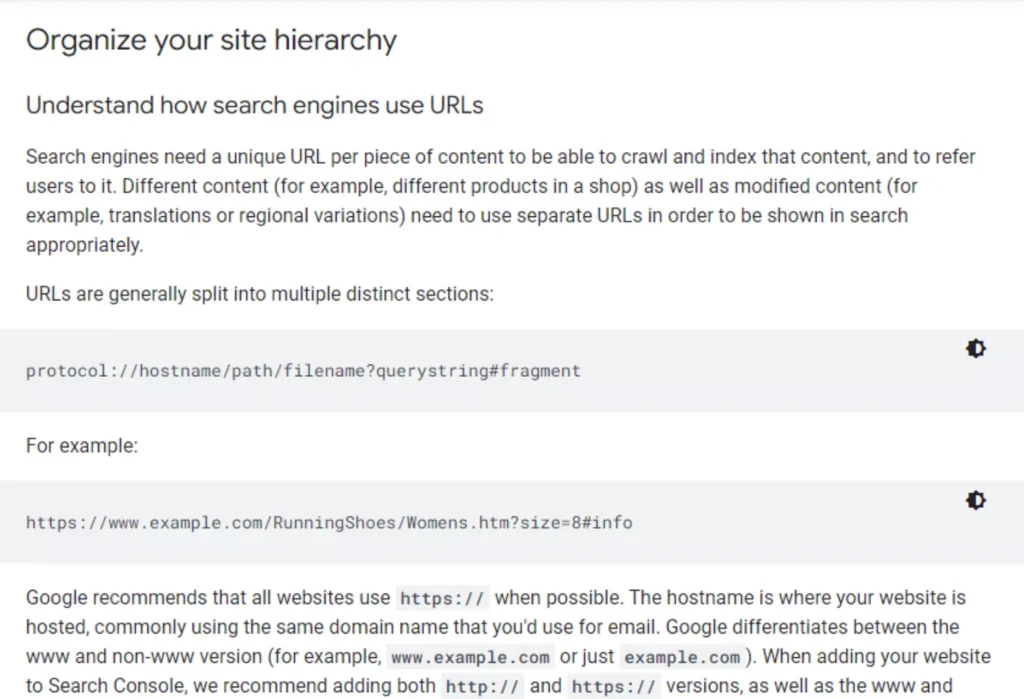URLs play a critical role in search engine optimization (SEO) as they serve as the addresses to access web pages.
A well-structured URL can greatly impact a website’s visibility in search engine rankings, while an optimized and user-friendly URL can improve the overall user experience.
In this article, let’s explore the importance of URL structure, URL optimization, and best practices for creating SEO-friendly and clean URLs.
Additional resources:
Technical SEO: The Key Elements You Need To Know
Why Conduct An SEO Audit? 5 Key Reasons
Understanding URL Structure:
A URL consists of several components that together form the address of a web page.
These components include the protocol (such as “http://” or “https://”), subdomain (optional), domain name, top-level domain, sub folder and slug.

Understanding the anatomy of a URL is crucial for optimizing and creating effective URLs.
A well-structured URL can improve search engine visibility, user experience, and overall website performance.
let’s understand each in detail:
- Protocol: The protocol, also known as the scheme, indicates the communication protocol used to access the resource. It defines the rules and standards for data transmission between the client (e.g., a web browser) and the server. Common protocols include “http://” for regular websites and “https://” for secure websites that use encryption.
- Subdomain: An optional part that appears before the domain name and is separated by periods. It can provide additional context or specify a particular subsection of a website. For example, in “blog.example.com,” the subdomain is “blog.
- Domain Name: The main part of the URL that identifies the website or server where the resource is hosted. It typically consists of a series of letters, numbers, and hyphens. In the example “www.example.com,” the domain name is “example.”
- Top-Level Domain (TLD): The TLD represents the category or type of the website. It is the last part of the domain name and is often denoted by a period followed by a few letters. Common examples include “.com” for commercial websites, “.org” for organizations, and country-specific TLDs like “.uk” for the United Kingdom.
- Path: The path in a URL can consist of multiple levels, separated by slashes (
"/“). Each level represents a different directory or subdirectory within the website’s structure.It’s important to optimize the path of a URL to provide meaningful information to users and search engines. By including relevant keywords and organizing the path logically, you can improve the understandability and search engine visibility of your URLs. For example, in “www.example.com/products/electronics,” “products” is the path.
- Slug: A slug is a user-friendly, descriptive part of a URL that identifies a specific resource within a subfolder. It typically appears after the subfolder and is separated by a slash (“/”). Slugs often contain keywords related to the content of the resource. For example, in “www.example.com/products/electronics/smartphone,” “smartphone” is the slug.
Here’s an example URL showcasing these six parts:
https://blog.example.com/articles/create-a-blog-in-wordpress In this example, the protocol is "https://," the subdomain is "blog," the domain name is "example.com," .com is the top-level domain, the path is "articles," and the slug is "create-a-blog-in-wordpress."
Importance of URL Optimization:
URL optimization directly affects a website’s visibility in search engine results pages (SERPs).
A well-optimized URL can enhance the website’s chances of ranking higher for relevant search queries.
Additionally, user-friendliness and readability are also important factors to consider when optimizing URLs, as they impact the user’s experience and their likelihood of clicking on the link.
In fact, URLs are so important that the Google Search Central guide dedicates an entire section to them.

URL Best Practices for SEO:
To ensure that URLs are optimized for search engines and user-friendly, there are several best practices to follow:
- Use of descriptive and relevant keywords: Incorporate target keywords in the URL to provide search engines and users with a clear indication of the page’s content. However, it’s important to avoid excessive keyword stuffing, as it can negatively impact the readability of the URL.
- Keep URLs concise and meaningful: Eliminate unnecessary parameters and query strings from the URL to make it more concise and clean. Create URLs that convey the context of the content, making it easier for users and search engines to understand what the page is about.
- Use of hyphens to separate words: When including multiple words in the URL, use hyphens (-) to separate them. Hyphens are preferred over underscores (_) as they are more readable and are recognized as word separators by search engines. Avoid using spaces and special characters in URLs, as they can cause issues with link accessibility and compatibility.
- Maintain consistency and avoid duplicate URLs: Ensure that each page on your website has a unique URL to avoid duplicate content issues. Implement canonical URLs and redirecting techniques to consolidate duplicate variations of URLs, improving the website’s overall SEO performance.
Creating SEO-Friendly URLs:
To create URLs that are optimized for search engines, consider the following practices:
- Remove dynamic parameters and session IDs: Dynamic parameters and session IDs in URLs can create long and complex addresses that are not user-friendly and can be challenging for search engines to crawl. Remove unnecessary parameters to create clean and concise URLs.
- Utilize static URLs for better indexing: Static URLs, which don’t change regardless of user interactions or dynamic content, are preferred for SEO purposes. They are easier to index, understand, and share. Consider implementing URL rewriting techniques to convert dynamic URLs into static ones.
- Implement URL rewriting techniques: URL rewriting allows you to modify the structure and appearance of URLs without changing the underlying content. Techniques such as using mod_rewrite in Apache or utilizing URL rewriting features in different content management systems (CMS) can help create SEO-friendly URLs.
Benefits of Clean URLs:
Using clean URLs offers several benefits for both users and search engines:
- Improved user experience and usability: Clean URLs are easy to read, understand, and remember. Users can quickly identify the content of a page just by looking at its URL, enhancing their overall browsing experience.
- Enhancing website accessibility and shareability: Clean URLs are more accessible to users and can be easily shared through social media platforms, emails, or other online channels. This improves the visibility and reach of your content.
- Facilitating website maintenance and updates: With clean URLs, website maintenance becomes more manageable. If you need to update or modify a page, you can do so without altering the URL, minimizing the risk of broken links and preserving the page’s SEO value.
Avoiding Common URL Mistakes:
To ensure that your URLs are optimized effectively, it’s important to avoid common mistakes, such as:
- Lengthy and convoluted URLs: Long and complex URLs are difficult for users to read and remember. Aim for concise and meaningful URLs that accurately represent the content of the page.
- Ignoring URL structure during website redesigns: When redesigning a website, it’s crucial to consider the impact on URL structure. Changing URLs without proper redirects can result in broken links and loss of SEO rankings. Ensure that URL changes are planned and executed correctly to maintain SEO integrity.
- Unoptimized URLs in content management systems: Some content management systems generate URLs automatically without considering SEO best practices. Review the default URL settings in the content management system (CMS) you’re using and customize them to align with SEO best practices. This includes removing unnecessary parameters, using descriptive keywords, and ensuring the URLs are clean and user-friendly.
Considerations for URL Internationalization:
For websites with an international audience or targeting multiple languages, it’s important to address URL internationalization considerations:
- Handling non-English characters in URLs: If your content includes non-English characters, such as accented letters or characters from different writing systems, make sure they are properly encoded in the URL to ensure compatibility and avoid any issues with URL parsing.
- Implementing language and region-specific URLs: For multilingual websites, consider implementing language-specific URLs that indicate the language of the content. Similarly, for websites targeting specific regions, region-specific URLs can be utilized to improve relevancy and user experience.
- Proper handling of URL redirects for multilingual websites: When redirecting users from one language or region to another, ensure that the appropriate redirect method is used to maintain SEO value and avoid confusing search engines. Implementing hreflang tags can also help search engines understand the language and regional targeting of your content.
Tools and Resources for URL Optimization:
There are several tools and resources available to assist you in optimizing your URLs for SEO:
- URL analysis tools: These tools analyze the structure and elements of your URLs, providing insights on areas for improvement and identifying any potential issues.
- URL rewriting plugins and modules: Content management systems often offer plugins or modules specifically designed for URL rewriting, making it easier to implement SEO-friendly URLs without the need for complex manual coding. Use Combo WP Rewrite Slugs plugin, rewrite your WordPress website URLs with not just ease but also with 100% accuracy.
- Webmaster guidelines and best practices: Search engines like Google provide webmaster guidelines and best practices that cover URL optimization. These resources offer valuable insights and recommendations to ensure your URLs align with search engine requirements and best practices.
Conclusion:
URL structure, optimization, and best practices are essential components of a successful SEO strategy.
By implementing SEO-friendly and clean URLs, you can improve your website’s visibility in search engine rankings, enhance user experience, and increase click-through rates.
Understanding the anatomy of a URL, following best practices, and utilizing available tools and resources will help you create URLs that are both search engine-friendly and user-friendly, ultimately contributing to the overall success of your website.
Now I would love to hear from you.
Make yourself known by leaving a comment here. I look forward to your response and welcome any other ideas as they emerge!
As a digital marketing consultant, My ultimate goal is to empower businesses to thrive in the digital landscape.
I believes that a well-executed digital strategy can transform a company’s online presence, drive growth, and create meaningful connections with target audience.
To Know More Click Here!







